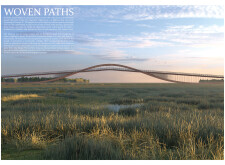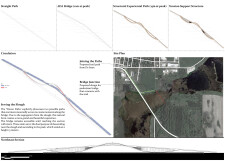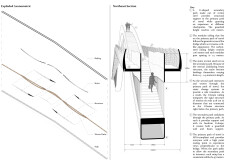5 key facts about this project
### Project Overview
Located in De Smet, South Dakota, the Woven Paths project aims to create a functional pedestrian bridge that integrates with the surrounding natural landscape. By utilizing the existing slough, the design establishes a vital link that provides access while inviting users to engage with the local ecology. The project seeks to enhance the community's interaction with nature through an experiential pathway that promotes exploration and awareness of the environment.
### Design Intent and Features
The design approach centers on the innovative concept of a horizontally oriented structure that aligns with the natural topography. The bridge features woven pathways that not only facilitate movement but also encourage exploration, with a primary ADA-compliant path that rises to a height of 15 meters at its peak. This includes ceremonial stairs leading down to various interaction points with the slough, allowing users to experience diverse elevations and panoramic views.
**Materiality:**
The project employs a selection of materials that reflect its commitment to durability and aesthetic integration. Corten steel is used for structural elements, creating a textured appearance that blends with the landscape, while carbon steel railings contribute to the bridge’s overall lightness. Transparent glass panels incorporated into the design enhance visual connectivity between users and their surroundings, allowing unobstructed views of the ecosystem.
### Sustainability and Accessibility
Woven Paths is designed with sustainability and ecological education in mind. It not only provides safe passage over the slough but also supports local biodiversity by preserving the habitat and offering vantage points that foster appreciation for the wetlands. The project adheres to inclusive design principles, ensuring accessibility for individuals with varying mobility needs while promoting a deeper connection between users and their environment through thoughtfully curated interactive moments along the bridge. Each viewpoint is intentionally designed to provide a distinct perspective of the landscape, creating a rich and diverse user experience.






















































